Discussing ReCore with Joseph Staten and Keiji Inafune: Crafting, combat, story and more
At Gamescom 2016, we had the honor of speaking to two legendary game developers.
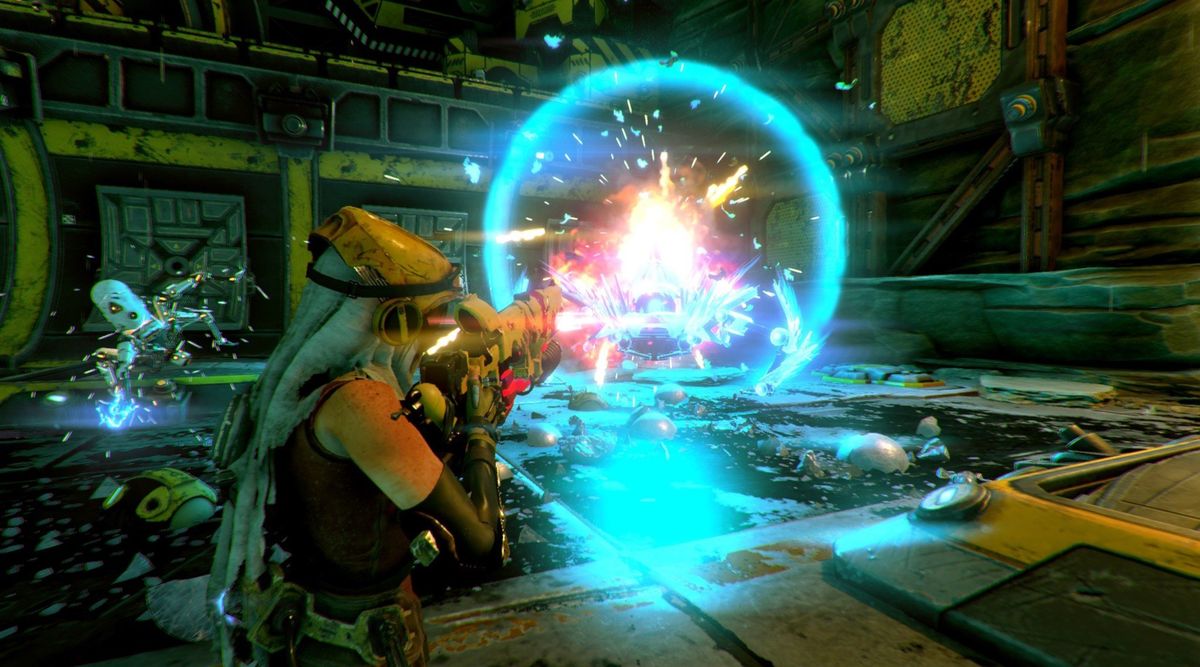
Keiji Inafune is renowned for his work on the likes of Megaman and Dead Rising, while Joseph Staten is famed for his work at Bungie on Destiny, and Xbox's premier franchise, Halo.
Keiji Inafune, Joseph Staten and Armature Studios of Metroid Prime fame are pooling their considerable talents into ReCore, a mechanized adventure title set on the extraterrestrial world of Far Eden.
We caught up with Inafune-san and Staten to discuss ReCore's story, its franchise potential, its unique gameplay, the depth of its systems, and how influences from classic titles like Megaman and Super Metroid fed into its overarching experience.
Jez Corden: I'll admit that, at first, ReCore didn't look like a game that would appeal to me personally, but when I played it at E3 2016 I found myself really enjoying it. The demonstrations you have here are quite gameplay heavy, however. I wondered how much of an emphasis story and narrative has in the full game.
Keiji Inafune: So ReCore takes place on a planet separate from Earth named Far Eden, and it focuses on Joule and her companion, Mack. They wake up from cryo-sleep in a post-apocalyptic setting. The player has to uncover exactly what happened. There's a very strong emphasis on the mystery element, as well as the exploration and the adventure elements. She's trying to investigate what happened to Earth, why the terraforming process on this new planet gone completely haywire, and why these robots are attacking you. The story plays a large part in ReCore. It's a solo, adventure-mystery.
As you explore Far Eden, you'll unlock this mystery of all those years that went by that Joule wasn't there to experience.
Jez: What sort of things can we expect from the story? Will it take cues from the likes of the Iron Giant, an emotional tale of woman and machine? Could ReCore be a tear-jerker?
Joseph Staten: Well, we don't want to spoil too much about the story, but when Joule starts out on this world of Far Eden, she's all alone. There are no other humans around – she expected there to be many humans. Joule went with a group of colonists, and more people were supposed to arrive from Earth. But when she wakes up, it's just her and Mack.
Get the Windows Central Newsletter
All the latest news, reviews, and guides for Windows and Xbox diehards.
The story is largely about Joule, gathering together these other Corebots, creating a little family together. The story is about how she meets these Corebots, what their relationships are, what challenges they overcome, but if you play the demo, you'll hear at least one other mysterious human voice in the game. The story is not just about Joule and the Corebots. It also goes into the history of mankind on Far Eden, even the history of the Corebots on Far Eden. There was a couple of centuries where Joule and the colonists were asleep, and the Corebots were out in the world doing their own thing. As you explore Far Eden, you'll unlock this mystery of all those years that went by that Joule wasn't there to experience.
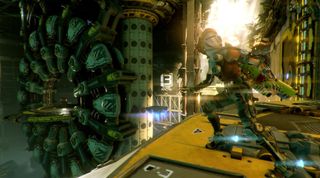
Jez: As I mentioned earlier, I saw ReCore's bright colors and Pixar-like robotic enemies, and thought that perhaps ReCore is targeted at a younger audience, that it would be easier, more simplistic and so on. But when I did get my hands on it I found that the combat had quite a lot of depth. Could you give us a little background on how the combat system evolved during development?
Joseph: Well the whole idea of color matching was bound up in the idea of the Corebots themselves. And this is something that Inafune-san and his team bought to the guys at Armature. They're both responsible for it. The idea is that the cores are the key to everything, the story, the combat.
The goal was to come up with a system that was really simple, but became deep with all the combinations.
From there, the idea was that we want the cores to have a unique set of strengths and weaknesses. Blue cores across the game should all do one certain thing for example. Blue cores are all about electrical, stunning attacks. Red cores are more about fire, as another example. The fun thing about ReCore is using those features in combination. Not just color matching, like 'blue on blue is good', but also placing cores within frames.
For example, the yellow cores are good at barrage attacks – but they only make missile-barrage attacks inside the spider frame. If you were to swap it into a different frame, it would produce a different attack. The same is true for the blue core. If you put a blue core into the dog frame, he does a dashing attack, but if it's in the spider frame, it'll do a stunning electrical beam.
All of this is to say that the goal was to come up with a system that was really simple, but became deep with all the combinations.
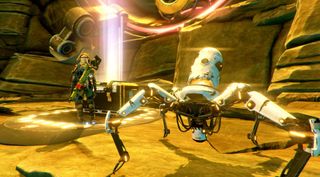
Jez: That's the sense I got from it. Easy to play hard to master?
Joseph: Exactly. So if you just remember to color match, blue on blue all the time, it seems really simple. But when you get into it, you realize that you're sometimes mixed with enemies of lots of different colors, and some which have different effects based on the frame that they're in. As a player, you're remembering colors, but it gets more complicated – in a fun way. It's about choosing the right tools to be most effective.
There are definitely places in the world that are all about exploring, grinding, getting those really high-powered armor sets for your Corebots so you can tackle more difficult dungeons or enemies.
Jez: Have we seen all the combat frames available in the game?
Joseph: Well in this demo you play against spiders, ape frames – the bigger gorilla-looking guys. As you can see from our artwork, there are more frames out there. One that looks like a flyer, one has little tank treads on it – so you can assume that you can have at least a couple of extra frames in the game. There's a number of smaller enemies called Corebites, and enemies larger than your own companion Corebots. There are many many different kinds of this other category of enemies, besides the animal-based frames that we've seen so far.
Jez: When I played the demo, I was getting loot drops and so on. Could you tell us more about what those are for?
Joseph: So when you're playing the game, you probably saw that you're picking up parts, materials, spider optics and beast knuckles and all of these parts that fall off the Corebots. The system is a blueprint system. So you'll have a recipe, ingredients, parts, and as you travel around the world, you're able to collect them and then make these blueprints into frame pieces for your Corebots.
You can upgrade the look of your dog, the look of the spider, the look of your beast. It's not just the look either, they have combat properties as well, stat changes. So Mack is a good example, you can find an armor set that will turn the normal Mack dog into a wolfish, pointed-snout type, or a big, heavy bulldog, and some other more exotic things too.



Joseph: As a player in combat, you're basically deciding two things when killing an enemy. Do you want to destroy them into parts that you can use to make new frame parts for your Corebots? Or do you want to pull out their core, and combine them with your friendly Corebots to increase their power?
So that's really the basics of the loot system. You're either pulling out cores to increase your friendly Corebots' base stats, or you're breaking enemies down into parts to upgrade your armor.
It's a really nice, deep system that's layered on top of this action platforming, and there are definitely places in the world that are all about exploring, grinding, getting those really high-powered armor sets for your Corebots so you can tackle more difficult dungeons or enemies.
You'll run into enemies fairly early on in the game that will be fairly higher level than you. They will be impossible to take down until you upgrade your Corebots.
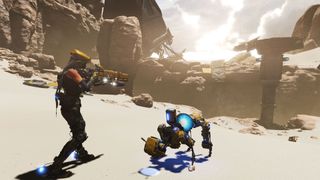
Jez: A lot of the enemies we've seen so far are on the smaller side. Can we expect bigger enemies? Big boss fights?
Inafune: Absolutely. I think there's definitely an old-school arcade-style element to this game. There are bosses made up of different parts, for example. I think that's definitely a large part of the game as you progress through the story.
Jez: On the dungeon front, are there optional dungeons? Or is it quite linear how you progress through the world? Will there be secret dungeons, secret bosses and that sort of thing?
Joseph: I'll just say without ruining the surprise that if you're a fan of Metroid and the idea that there are places in the world that you just can't get to right away. They're teasing you, tantalizing you. "If I just had the right thing to get up high to get to that door I could go and explore it." Recore is the exact same way. There are absolutely places in the world that you'll see early, that you won't be able to get to, that you'll be able to come back to later.
We hope players get that magical, classic-feel when they play ReCore.
Jez: I remember discovering those obscure, hidden secrets in Super Metroid. Are you saying that sort of feeling is within ReCore?
Joseph: Absolutely. I think that's the same kind of feeling we want people to get in ReCore. That fun of discovery, and feeling like in a place that you shouldn't be? But of course, you are supposed to be there. It's that same magic.
The whole idea about ReCore is that we want to take the spirit of those sorts of games and bring them to modern PCs and Xbox One, with better graphics and those sorts of things. ReCore really is a third-person action adventure in the style of Metroid and Megaman. We hope players get that magical, classic-feel when they play ReCore.

Jez: I did talk to Armature Studios' Mark Pacini about ReCore's lower price point, but I wondered if you could provide any insight on the mentality when it came to the decision to price it lower than a typical big game release.
Inafune: So the price point was decided very early on in collaboration with Microsoft. The reason they did that strategic price point was to try to appeal to a much wider audience. Microsoft already has a wide library of mature rated games that are for the super-hardcore and the older target audience. But with ReCore, what we're trying to do is make something a little lighter, it has a teen rating, but it still has a lot to offer fans from all sorts of audiences.
ReCore leans much more heavily towards action – but that doesn't mean to say puzzling and story takes a back seat.
Jez: Could you estimate roughly how long ReCore will take to complete? And how much of that time will be split up between narrative, combat, puzzling and so on.
Inafune: So the game takes around eight to ten hours for our playtesters who know the direct path, start to finish. That doesn't include exploring, finding the extras, easter eggs and so on.
So I would certainly say in terms of how everything is oriented, ReCore leans much more heavily towards action – but that doesn't mean to say puzzling and story takes a back seat. I would probably place it at around two-thirds action, with puzzling and storytelling taking up around one-third. A lot of those gameplay aspects are integrated seamlessly, story elements will show up through segments even in combat, with voice overs.
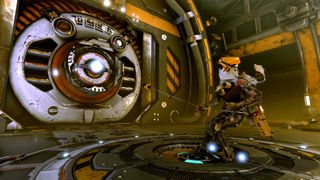
Jez: Could ReCore evolve into a franchise as big as Halo one day? I feel that it represents a unique place in the Xbox One line-up, and with Nintendo sitting on the Metroid franchise you could be filling a gap in a lot of people's hearts with ReCore. Is it designed with sequels in mind? Or will ReCore just be a one-shot?
Joseph: Well, when we made Halo 1 at Bungie we didn't know we were going to get to do a sequel. We wanted to get the best game possible onto the disc, and then hope people enjoyed it. We earned a sequel. Every game in the global publishing portfolio – whether it's ReCore, or Crackdown or Scalebound – we have aspirations and hopes that they can go on and grow into 'big boy' franchises like Gears, Forza or Halo. But you have to earn that success. You have to build an audience.
We've approached ReCore in the same way that we approached the Halo games – let's put as much quality in there as we can, let's attract as broad of an audience as possible, and let's do our best to earn a sequel.
We've approached ReCore in the same way that we approached the Halo games: let's put as much quality in there as we can, let's attract as broad of an audience as possible, and let's do our best to earn a sequel. If we do? That's awesome. We certainly have ideas on where we want to take the story, but you never really know. But I think ReCore is a pretty special game, I love the way it plays, I hope people enjoy it.
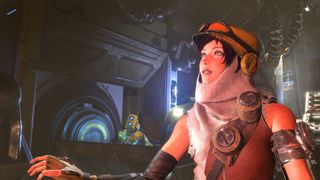
Huge thanks to Joseph Staten and Keiji Inafune for talking to us!
ReCore will be the first title to hit Xbox Play Anywhere, allowing users to play digitally across either Xbox One or a capable Windows 10 PC with a single purchase. It's also the first title to emerge from the Xbox One's exclusive Fall-Holiday line-up, joining heavy weights like Gears of War 4 and Forza Horizon 3.
As a Super Metroid fan, I'm always excited to dive in to games that revisit that classic formula, and from what little I've experienced of ReCore so far, I'm hopeful that Comcept Inc and Armature Studio can deliver on their promises.
Are you interested in ReCore? Let us know in the comments, or hit the link below for some hands-on impressions from E3!
ReCore launches on September 13th, 2016 exclusively on Xbox One and Windows 10.

Jez Corden is the Executive Editor at Windows Central, focusing primarily on all things Xbox and gaming. Jez is known for breaking exclusive news and analysis as relates to the Microsoft ecosystem while being powered by tea. Follow on Twitter (X) and Threads, and listen to his XB2 Podcast, all about, you guessed it, Xbox!